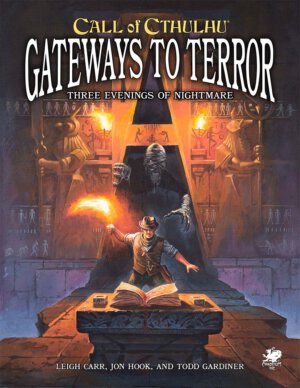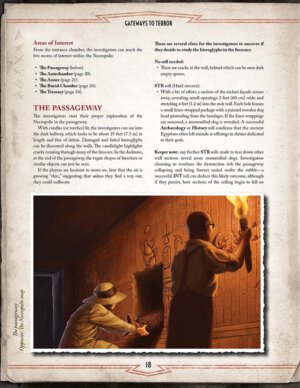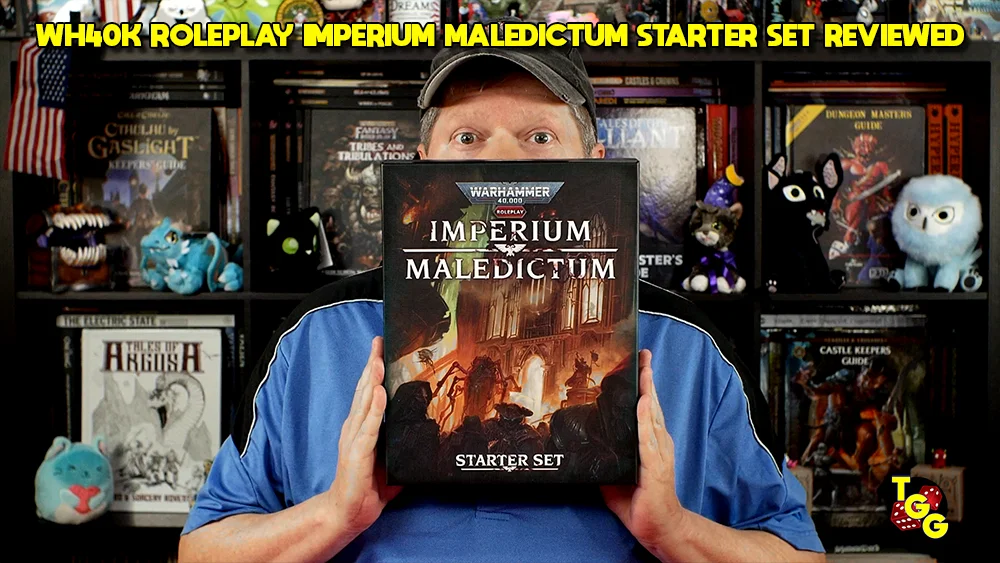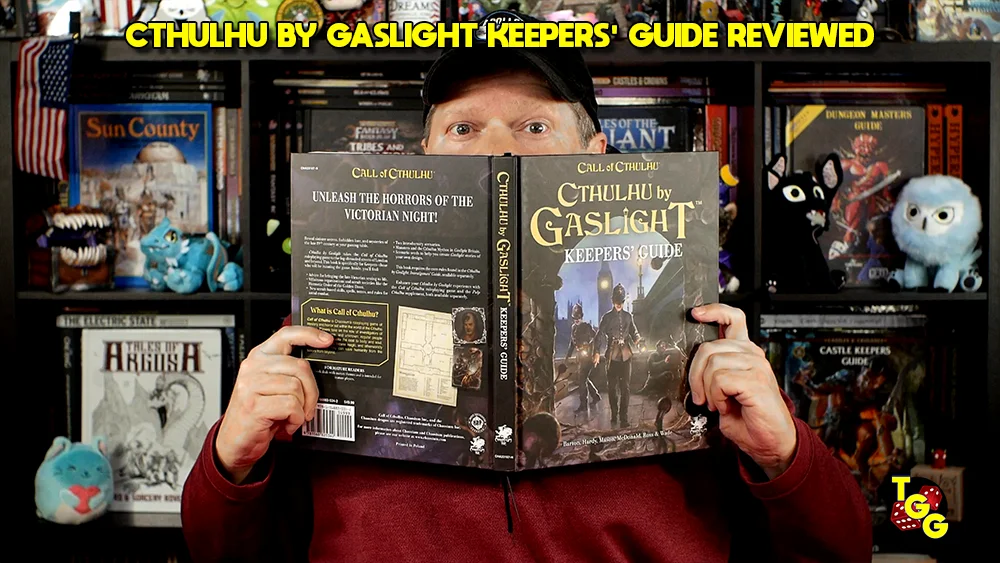
Publisher: Chaosium Inc
Authors: Leigh Carr, Jon Hook, and Todd Gardiner
Artists: Mariusz Gandzel, Chris Huth, and Matt Ryan
Genre: Call of Cthulhu adventure collection
Year: 2019
Pages: 88 pages
MSRP: $19.99 for the softcover (including the PDF) or $9.99 in PDF at DriveThruRPG
You can check out another opinion with Jeff’s video review of the softcover right here.
One of the trickiest things any GM or author (and they are often the same) needs to learn is time management. Many of us are used to thinking in terms of a four-hour convention slot, which can often be adapted to a single evening of gaming. But what if you don’t have four hours? What if you only have one?
If it’s Call of Cthulhu you want to run, Gateways to Terror has you covered. This book has three scenarios, each with four pre-generated investigators, a timeline for play, notes for deviating from both, and, of course, the adventure itself, complete with top-notch maps, handouts, and illustrations.
The book opens with an introduction giving an overview and advice for running the scenarios. This includes reminders about things like the option to spend Luck and the different rules sets. Page numbers are provided for both the Call of Cthulhu: Keeper Rulebook and the Call of Cthulhu Starter Set. The introduction is a good walk through for GMs, both new and experienced.
All three adventures are survival horror. The first is “The Necropolis”, where the investigators are trapped in an excavated tomb in the Valley of the Kings and must make their way out. Of course, they aren’t alone in the tomb. It is strongly implied that some of the local workers deliberately trapped the investigators, and the scenario very much leans into Nyarlathotep’s Black Pharaoh avatar. On the other tentacle, it is also implied that most of the workers are not secretly working for an evil cult.
The next adventure is “What’s In the Cellar?” The investigators are searching the eponymous cellar in an attempt to find evidence to clear a man of murder. He insists that the actual killer was some kind of monster. The investigators will, of course, learn that he is correct. This scenario makes use of the idea that a sorcerer’s descendants will eventually run afoul of their ancestor’s deeds, and does a solid job of it without needing to add racism on top of that.

Each scenario is a good combination of mystery and survival horror. Each makes the clue trail clear to the reader, as well as what is at stake. Mostly, it’s the investigators’ survival that’s at stake, and while the monsters in each scenario will attempt to escape and cause mayhem and death, we’re not talking about the end of the world here.
And, while the basics are the same — survive in an enclosed space with a monster — this collection shows how varied scenarios using them can be in the hands of authors who excel at their craft. Nor are they the only ones making this collection shine. The handouts and illustrations are spot on. And the maps are amazing. Not only are they crystal clear about where everything is; there are multiple versions of the maps so that GMs can hand players something that does not say “Clues are over here!” “The Necropolis” has two different versions of the map for players: one for when they first start exploring the tomb and one for when they learn the full extent of it.
There are a couple of typos (e.g., “waiver” for “waver”) and one “page @@” (I believe the page in question is page 76). Hopefully, these will get fixed before the book is printed.
All of the pre-generated investigators are in the main PDF as plain text collections of skills, stats, and so forth. Their character sheets are collected in a separate PDF.
The investigators are given as much personality as necessary and not one iota more. They are referred to by their roles in the scenario; it is for players to name their characters. This is a good choice. I have seen how much investment in a pre-generated character grows when a player gets to name them.

I see nothing to keep players from deciding their characters’ race or religion, and there’s also a lot of flexibility for nationality. The investigators in “What’s In the Cellar?” and “The Dead Boarder” are all gender neutral, as are three of the four investigators in “The Necropolis”.
The fourth is an ex-soldier, and it is presumed that such a character must be male. I have lost track of the number of times I have recommended someone read this article and this post but add one more to that number, and make that ex-soldier any gender you dang well please.
Each scenario has suggestions for involuntary reactions and behaviors while temporarily insane for each investigator. Sanity as a stat and the mechanical effects surrounding it are hard baked into Call of Cthulhu. And, as time goes on, this is an utter turnoff for more and more players.
This leaves me very mixed on the material. That said, if you’re running Call of Cthulhu – and you’re using the Sanity rules – it is better to have guidelines than to suddenly realize you don’t know what to do with a character who’s lost a bunch of Sanity. Such guidelines are a net positive with the caveat that the larger battle is still being fought by players, not characters, who are neurodivergent and by their allies inside and outside of gaming.
Whatever you decide to do with the sanity loss guidelines, the scenarios are all solid. They can be used to fill a one hour slot or, if you have more time or more players, a longer one. Any of the scenarios can serve as an introduction for new players to roleplaying games in general and Call of Cthulhu in particular.
[rwp-review id=”0″]
















